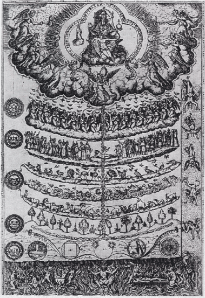The first phylogenies
Although graphical representations of the evolutionary tree of life reflecting descent with modification as envisioned by Darwin and Wallace necessarily postdate the development of evolutionary theory, the representation of nature in tree, network or some other hierarchical form is considerably older.
For example, order imparted by an omnipotent Christian deity was viewed as a hierarchy that encompassed all inanimate and living beings in the universe. Many drawings and paintings of this so-called chain of being were made, including the wonderfully detailed one to the left by the Franciscan missionary Didacus Valades. Note that there are variations in the hierarchy although invariably there is a progression from mineral through plants and animals, to humans, angels and the supreme being at the top. Note too that this in no way represents a genealogy as we would think of it but is simply an artist’s rendering the universe created by a Christian god. By the late 18th Century the notion of the chain of being had fallen out of favour and we begin to see the emergence of trees and networks representing relationships among organisms (see Mark Ragan’s excellent and detailed article on this: Ragan. 2009. Trees and networks before and after Darwin. Biology Direct 4:43 doi:10.1186/1745-6150-4-43). Certainly in the late 1700s and early 1800s we see (or read about) elements of geneaological graphical representations in the work of such famous naturalists as Buffon (1707 – 1788) or Peter Simon Pallas (1741 – 1811).
Darwin is often credited with having provided us with the first true evolutionary tree. For example, in his 1837 Notebook B we see the diagram with explanation shown to the left here. The text associated with this figure reads:
“I think … case must be that one generation should have as many living as now. To do this and to have as many species in same genus (as is) requires extinction. Thus between A + B the immense gap of relation. C + B the finest gradation. B+D rather greater distinction. Thus genera would be formed. Bearing relation” (on the subsequent page) “to ancient types with several extinct forms.”
Some biologists demur and think that this is an oversight and slight to earlier thinkers. For example, Lamarck did indeed use the visual tree metaphor in his important book, Philosophie Zoologique (1809). However, its important to note that this diagram did not reflect a belief in the descent from a single common ancestor and thus some notion of all species have come from a single common ancestor. Rather, Lamarck’s tree summarizes his assertion that there are multiple independent origins of distinct trajectories that progress through different forms over time. Note that this tree is inverted from the tradition representations of trees.
American geologist Edward Hitchcock (1793-1864) included a fold-out chart in all but the last editions of his book Elementary Geology that shows multiple lineages of organisms. Hitchcock was a contemporary of Darwin but rejected evolution (and wrote an article “refuting” natural selection and atheistic evolution). Indeed Hitchcock asserted that God was the cause of organic change and that species weere created throughout the history of the world.

Haeckel’s tree of life published in Generelle Morphologie der Organismen (1866) with the three branches Plantae, Protista, Animalia.
One of the most famous trees ever published is by the renowned German zoologist, embryologist and philosopher, Ernst Haeckel. Haeckel was a fervent advocate of evolution and Darwinism but made huge contributions in his own right, even coining the term phylogeny! This early tree, published in Generelle Morphologie der Organismen’ (1866), seven short years after Darwin’s The Origin, shows three groups, plants, animals and protists, and a clear pattern of descent and ramifying lineages from common ancestors.
Haeckel published another tree (in 1874) that is one of my favourite figures in the history of publication in evolution (below). It once again has a quite literal tree underlying Haeckel’s representation of the genealogy of life. It also has humans at the pinnacle of the tree, because it was then (and often erroneously also today) thought that humans were the zenith of evolution.





In his 1874 book “Anthropogenie” Haeckel most likely placed Man at the top of his tree not because he thought humans to be the “zenith of evolution,” whatever that means, but for two very different reasons.
First, Haeckel designed Anthropogenie as a popular treatment to promote the idea of the biological evolution of man, through natural selection, to an educated German public. The special place of man was the bias of his audience, something that required placating for Haeckel to make his arguments effective.
Second, Haeckel maintained that Man was objectively more complex than other kinds of animals as a consequence his possessing of language, reason and culture. For Haeckel, these were evolved traits that greatly expanded Man’s complexity, his yard stick of evolutionary advancement. Haeckel was a militant materialist, and there is nothing to suggest he believed either that evolution was guided to produce Man or that human evolution, or any evolution for that matter, had reached an end point. In fact, Haeckel commented that human intelligence would be further perfected by natural selection (as it had been in the past) and brighter days were in the offering.
Woody,
I do appreciate the input, and even the derogatory comment on my usage of the word zenith. I must say that I am impressed that you have time to comment on a blog for a modest biology course from a small Eastern Ontario university.
regards
Steve